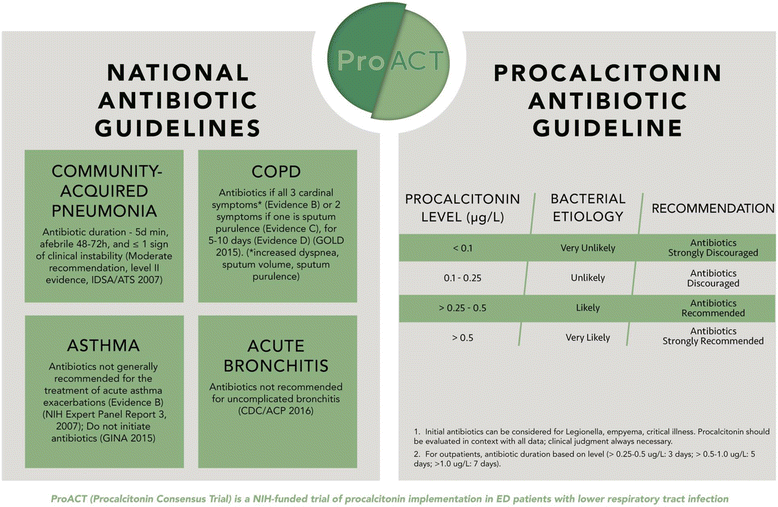Design and rationale of the Procalcitonin Antibiotic Consensus Trial (ProACT), a multicenter randomized trial of procalcitonin antibiotic guidance in lower respiratory tract infection
- PMID: 28851296
- PMCID: PMC5576372
- DOI: 10.1186/s12873-017-0138-1
Design and rationale of the Procalcitonin Antibiotic Consensus Trial (ProACT), a multicenter randomized trial of procalcitonin antibiotic guidance in lower respiratory tract infection
Abstract
Background: Overuse of antibiotics is a major public health problem, contributing to growing antibiotic resistance. Procalcitonin has been reported to be commonly elevated in bacterial, but not viral infection. Multiple European trials found procalcitonin-guided care reduced antibiotic use in lower respiratory tract infection, with no apparent harm. However, applicability to US practice is limited due to trial design features impractical in the US, between-country differences, and residual safety concerns.
Methods: The Procalcitonin Antibiotic Consensus Trial (ProACT) is a multicenter randomized trial to determine the impact of a procalcitonin antibiotic prescribing guideline, implemented with basic reproducible strategies, in US patients with lower respiratory tract infection.
Discussion: We describe the trial methods using the Consolidated Standards of Reporting Trials (CONSORT) framework, and the rationale for key design decisions, including choice of eligibility criteria, choice of control arm, and approach to guideline implementation.
Trial registration: ClinicalTrials.gov NCT02130986 . Registered May 1, 2014.
Keywords: Anti-bacterial agents; Biomarkers; Clinical trial; Methods (MeSH); Procalcitonin; Respiratory tract infections.
Conflict of interest statement
Ethics approval and consent to participate
The University of Pittsburgh Institutional Review Board approved the ProACT trial.
Consent for publication
Not applicable.
Competing interests
David T. Huang receives grant funding from ThermoFisher for a study examining the microbiome in lower respiratory tract infection.
Publisher’s Note
Springer Nature remains neutral with regard to jurisdictional claims in published maps and institutional affiliations.
Figures
Similar articles
-
Procalcitonin-Guided Use of Antibiotics for Lower Respiratory Tract Infection.N Engl J Med. 2018 Jul 19;379(3):236-249. doi: 10.1056/NEJMoa1802670. Epub 2018 May 20. N Engl J Med. 2018. PMID: 29781385 Free PMC article. Clinical Trial.
-
Procalcitonin guided antibiotic therapy and hospitalization in patients with lower respiratory tract infections: a prospective, multicenter, randomized controlled trial.BMC Health Serv Res. 2007 Jul 5;7:102. doi: 10.1186/1472-6963-7-102. BMC Health Serv Res. 2007. PMID: 17615073 Free PMC article. Clinical Trial.
-
Procalcitonin-guided antibiotic use vs a standard approach for acute respiratory tract infections in primary care.Arch Intern Med. 2008 Oct 13;168(18):2000-7; discussion 2007-8. doi: 10.1001/archinte.168.18.2000. Arch Intern Med. 2008. PMID: 18852401 Clinical Trial.
-
Procalcitonin for guidance of antibiotic therapy.Expert Rev Anti Infect Ther. 2010 May;8(5):575-87. doi: 10.1586/eri.10.25. Expert Rev Anti Infect Ther. 2010. PMID: 20455686 Review.
-
[Antibiotics or not--procalcitonin can guide therapeutic choices. At least at the emergency department for adults with lower respiratory tract infection].Lakartidningen. 2010 Apr 14-20;107(15):985-8. Lakartidningen. 2010. PMID: 20464915 Review. Swedish. No abstract available.
Cited by
-
Implementation of the Procalcitonin Assay in a Rural Hospital.Hosp Pharm. 2018 Dec;53(6):395-402. doi: 10.1177/0018578718762128. Epub 2018 Mar 7. Hosp Pharm. 2018. PMID: 30559527 Free PMC article.
-
Procalcitonin-Guided Antibiotic Therapy Reduces Antibiotic Use for Lower Respiratory Tract Infections in a United States Medical Center: Results of a Clinical Trial.Open Forum Infect Dis. 2018 Dec 3;5(12):ofy327. doi: 10.1093/ofid/ofy327. eCollection 2018 Dec. Open Forum Infect Dis. 2018. PMID: 30619913 Free PMC article.
-
Procalcitonin-Guided Use of Antibiotics for Lower Respiratory Tract Infection.N Engl J Med. 2018 Jul 19;379(3):236-249. doi: 10.1056/NEJMoa1802670. Epub 2018 May 20. N Engl J Med. 2018. PMID: 29781385 Free PMC article. Clinical Trial.
-
Pidotimod in the treatment of pediatric recurrent respiratory tract infection.Pak J Med Sci. 2019 Jul-Aug;35(4):981-986. doi: 10.12669/pjms.35.4.82. Pak J Med Sci. 2019. PMID: 31372128 Free PMC article.
-
Evaluation of a Pharmacist-Driven Procalcitonin Protocol for Lower Respiratory Tract Infections Using a Clinical Decision Support System.Hosp Pharm. 2021 Oct;56(5):569-575. doi: 10.1177/0018578720931450. Epub 2020 Jun 8. Hosp Pharm. 2021. PMID: 34720162 Free PMC article.
References
-
- Metlay JP, Camargo CA, Jr, MacKenzie T, McCulloch C, Maselli J, Levin SK, Kersey A, Gonzales R. Cluster-randomized trial to improve antibiotic use for adults with acute respiratory infections treated in emergency departments. Ann Emerg Med. 2007;50:221–230. doi: 10.1016/j.annemergmed.2007.03.022. - DOI - PubMed
Publication types
MeSH terms
Substances
Associated data
Grants and funding
LinkOut - more resources
Full Text Sources
Other Literature Sources
Medical


